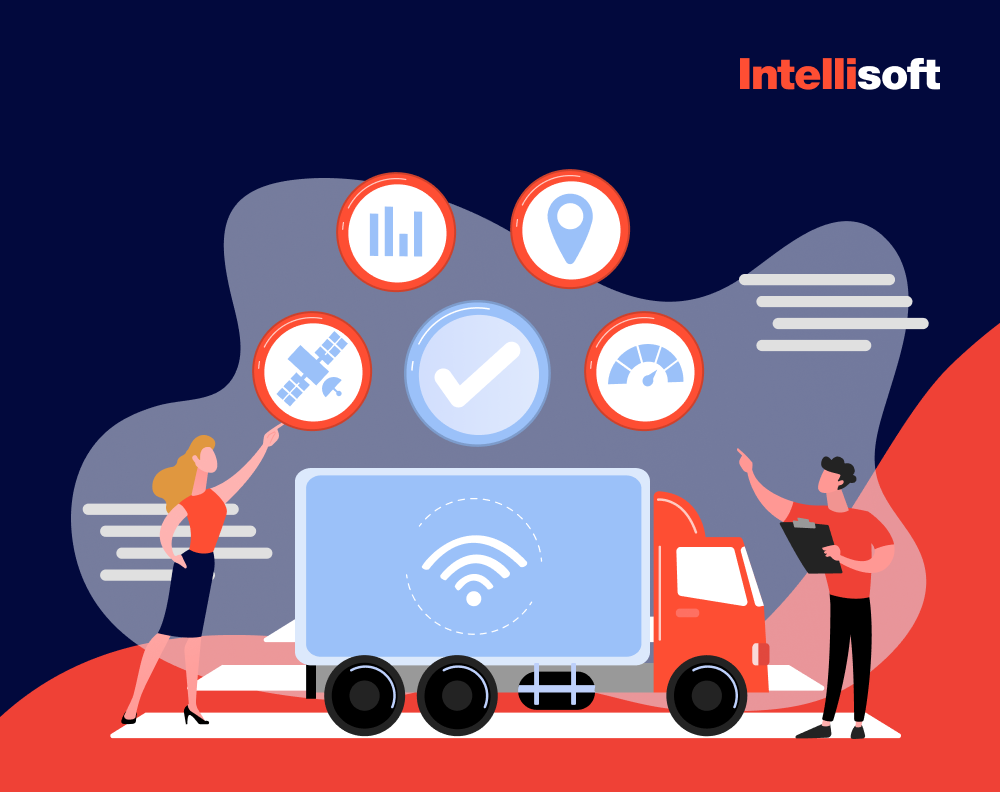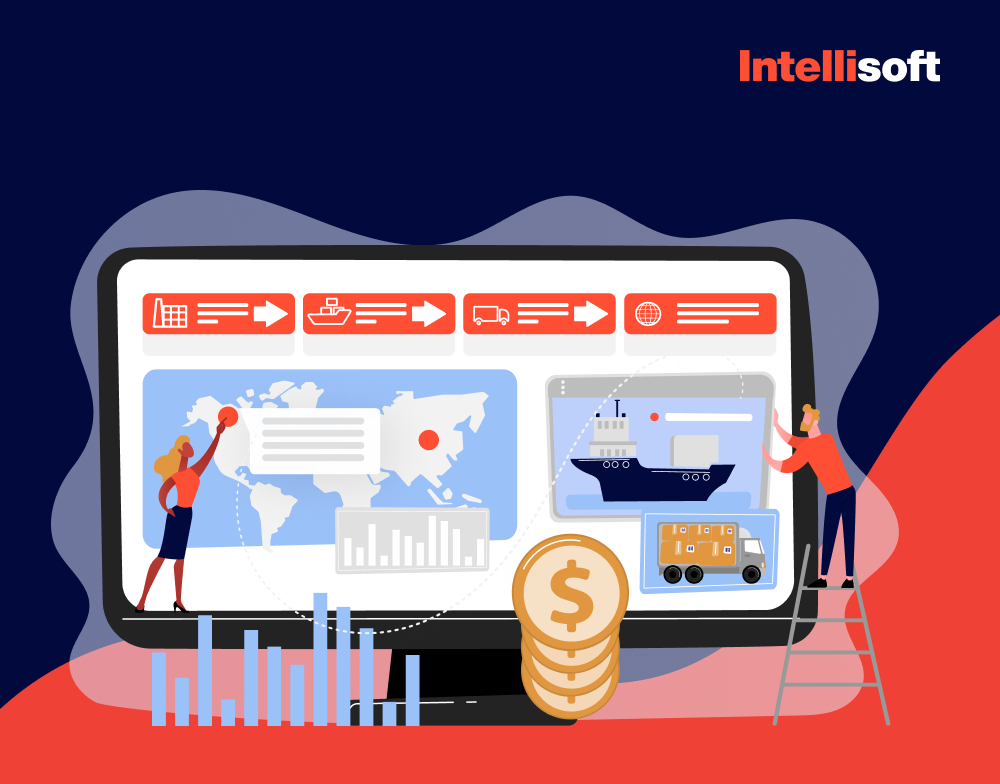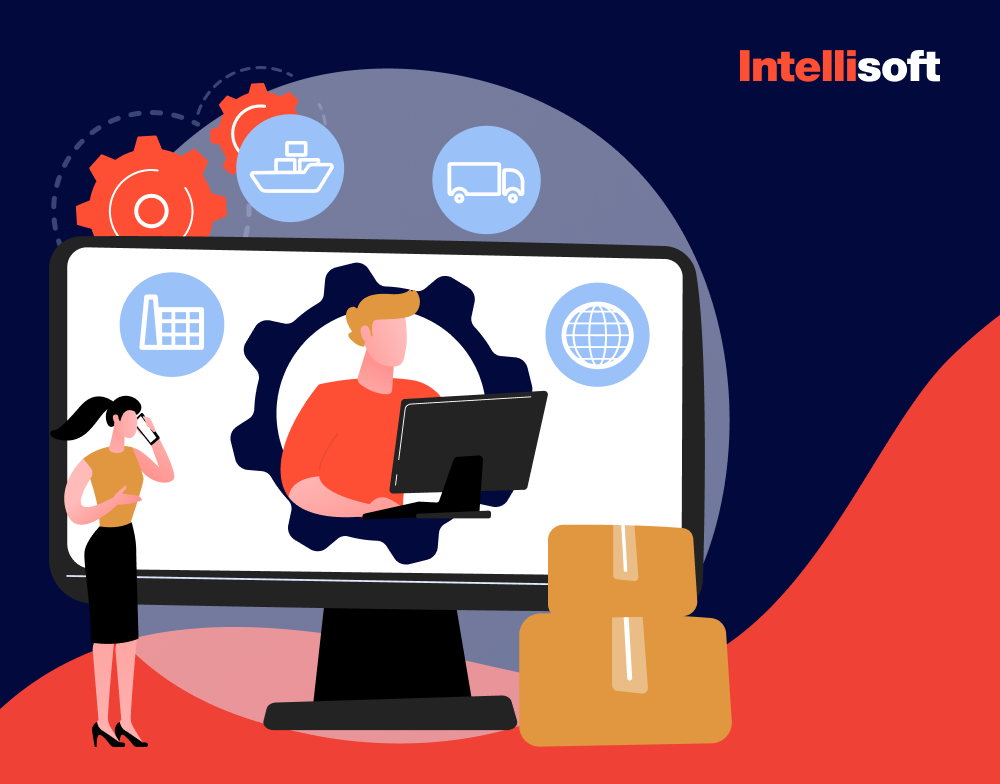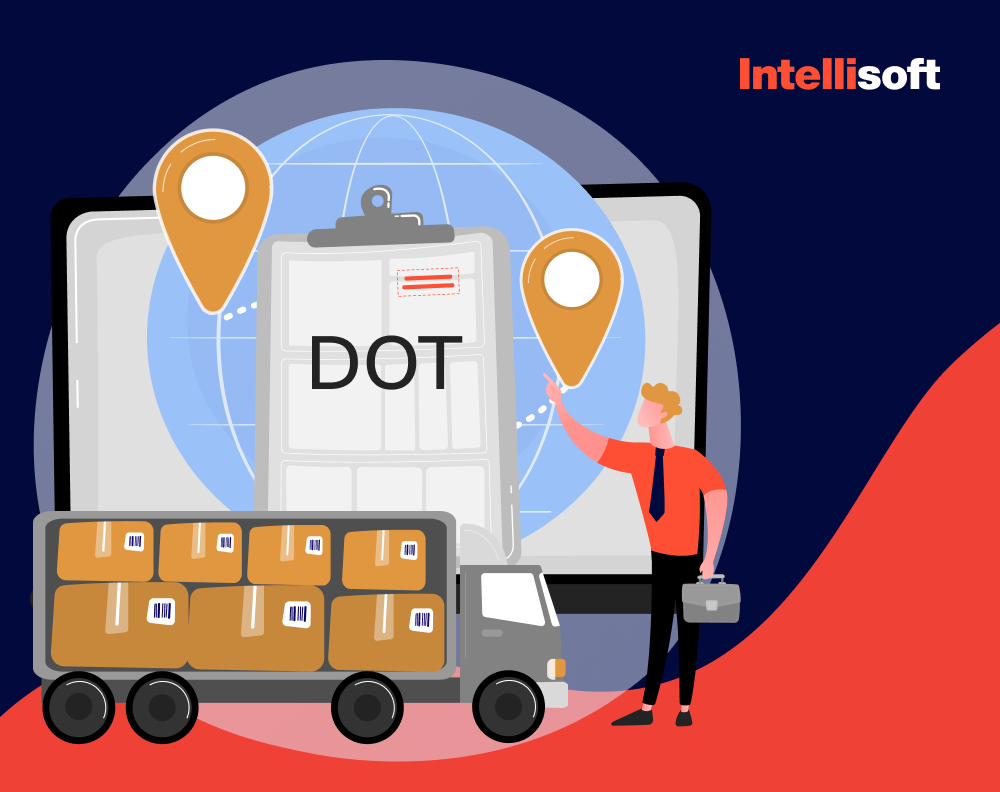As a logistics business owner, you always seek ways to increase efficiency and reduce operation costs. One way to do this is by using fleet and driver management systems. These systems help to manage and protect vehicle users and are becoming increasingly popular. According to Berg Insight, the usage of these systems has been growing for years and is expected to reach 22.2 million units in North America by 2024. This is expected to have a penetration rate of around 62 percent among non-privately owned commercial vehicles.
Fleet management systems and driver management systems go hand-in-hand. While fleet management system helps to optimize the performance of an entire fleet of vehicles, a driver management system focuses on improving the performance of individual drivers, benefiting the entire fleet.
Let’s learn more about truck driver management systems and ways to integrate them into your business. We will also share an experience of Intellisoft’s development team in logistics software development.
Table of Contents
Why Driver Management Is Important?
Truck drivers are subject to a set of regulations known as the Federal Motor Carrier Safety Regulations. These rules are established in a subchapter under Title 49 of the Code of Federal Regulations and are meant to ensure safe interstate and intrastate commerce and transportation.
One crucial category of these regulations is “Hours of Service.” For instance, those who transport goods (not passengers) are prohibited from driving for more than 11 hours (or 10 hours consecutively) within 24 hours. Additionally, they can only drive up to their 14th hour after starting their workday, regardless of how many hours they have driven that day. They are also prohibited from driving for more than 60 hours within 7 days or 70 hours within 8 days. If they do drive for 70 hours within 8 days, they must rest for 34 consecutive hours before driving again. Furthermore, they must take a 30-minute break during the first 8 hours of their workday. The rules for people transporting passengers are similar but slightly different.
In the past, vehicle users had to maintain written logs to comply with the Hours of Service regulations. However, with modern technology, most commercial motor vehicles, particularly tractor-trailers, must have “Electronic Logging Devices” installed. These devices work in conjunction with the drivers’ logs to verify compliance. An Electronic Logging Device captures information from the truck’s engine and records to the management engine interface driver system when the engine is running, when the vehicle is moving, how far it has traveled consecutively, and how long it has been in operation. This data is automatically saved and can be used by the fleet driver management software to determine if a person has followed the Hours of Service regulations.
Why Does Driver Management Need Improvement?
It is common for modern driver management to be overlooked in the pursuit of improved performance and higher revenue. However, creating a better working environment for drivers is essential. It is not always necessary to raise salaries or provide more days off. Instead, it is vital to ensure that workloads are distributed effectively and that the tools required for the job are convenient and user-friendly. In general, each technology makes life easier. Therefore, when it comes to drivers, the tools they use, such as vehicles or log books, must be easy to use.
Regulations compliance
Compliance is a burden for all stakeholders involved. Managers must monitor the working hours of each person to avoid penalties, which can be pretty costly. Incorrect or missing data about the vehicle’s technical status or the driver’s work log leads to more time and expenses spent on fixing it.
Safety
It’s important to remember that safety on the road isn’t just about following traffic rules — it’s about the overall attitude and habits of the driver. While violations of road safety rules may result in fines, bad driving habits can be a silent threat. However, companies can now use IoT sensors to gather data on a driver’s behavior while they’re behind the wheel, providing valuable insights into how they can improve their habits and become safer drivers.
Productivity
Are you aware of the weaknesses in your operations? Have you observed how driver productivity impacts them? Instances like no-shows, delays, and waiting times are often deemed unavoidable. However, there are multiple ways to mitigate the harm they cause. If you’re wondering how to enhance operational efficiency using technology, you need driver management software.

What is Driver Management Software?
Driver management software is a specialized tool that aims to optimize the performance and safety of personnel in a fleet. It uses fleet data to create a productive and safe working environment for vehicle users, focusing specifically on the personnel operating vehicles rather than the vehicles themselves.
This software helps boost fleet operations, reduce running costs, and improve safety and security. It offers on-site data access with geofences, replays of driving incidents or trips, and shared vehicle reports. These features help improve driver productivity and safety by providing more visibility, accountability, and control over the delivery fleet.
Related Articles:
- Uber For Trucks App Development: Essential Features and Costs
- Last-Mile Delivery Software Development: a Complete Guide
- How Predictive Analytics Solutions Are Benefitting Supply Chain
- The Foundation of Uber: The Tech Stack and Software Architecture
- Machine Learning in Logistics Industry: Benefits and Use Cases
Top Benefits of Driver Management Software
If you want to enhance your fleet operations, specific software can offer several valuable features. It can assist you in optimizing your fleet operations while ensuring your drivers are safe and efficient. To get the most out of this software, considering the crucial factors that make it effective is essential. Here are some key factors to look for when selecting fleet driver management software.
Driver Performance Insights
Driver performance management is a crucial aspect of managing drivers effectively. By tracking metrics such as fuel consumption, safety history, and punctuality, managers can identify areas that require improvement and develop strategies to increase productivity. Additionally, this data-driven approach allows managers to recognize and reward those who excel, fostering a culture of excellence.
Regulation Adherence
Staying compliant with rules such as the Hours of Service (HOS) and Electronic Logging Device (ELD) mandates can be challenging. Fortunately, a compliance tracking feature can help you stay on top of everything by automating oversight and minimizing the chances of breaching the rules, which could result in penalties (for example, the rules regarding hours can be challenging to keep up with).
Effective Driver Communication
Effective communication is crucial for the success of a fleet. A driver management tool that provides instant messaging and real-time alerts can greatly facilitate interactions with your personnel. These features enable you to stay up-to-date with your personnel, whether for real-time updates, maintenance alerts, or safety advisories.
Automated Vehicle Upkeep
Maintaining the reliability and safety of the fleet requires consistent vehicle maintenance. Managers can use various tools to effortlessly track maintenance cycles and ensure that vehicles receive the necessary care and attention. This approach helps reduce the risk of breakdowns or mishaps resulting from neglect.
Focused Driver Training
Ongoing education for personnel is a crucial aspect of maintaining the efficiency and safety of a fleet. By implementing truck driver management systems, fleet managers can provide their vehicle users access to a wealth of training materials. These systems also keep track of each driver’s learning progress and methods, ensuring that every person is equipped with the most up-to-date knowledge and skills needed for driving on the road.

Key Features of Truck Driver Management Software
An effective driver risk management system needs to have a range of features that can facilitate compliance with regulations, track relevant data, provide training to drivers, and streamline various aspects of daily vehicle operations. These features are essential for ensuring optimal performance and safety, and can help organizations stay on top of their operations while minimizing risks and maximizing efficiency.
- Real-time Monitoring. Real-time alerts and updates are provided on unique activities, such as speeding, harsh braking, and route deviations.
- Route Optimization. Driver fleet management system service provides route planning and optimization tools that can help you streamline your operations, increase efficiency, and reduce fuel costs.
- Telematics Integration. Telematics data helps users gain insights on fuel consumption, vehicle upkeep, and fleet management driver behavior.
- Compliance Management. This tool automates reminders for compliance deadlines, licenses, and certifications. It helps vehicle users stay up-to-date with their important requirements and ensures they comply with regulations.
- Safety Monitoring. Driver management system detects and signal potentially dangerous driving actions such as speeding and abrupt braking, encouraging the adoption of safer driving practices.
- Performance Tracking. The system monitors various performance metrics to assess their efficiency and productivity.
- Scorecards. The service offers users safety scores, promoting accountability and enhancing their overall performance.
- Documentation and Record Keeping. The modern driver management system maintains organized records of personal information, vehicle usage expenses, repairs, and fuel card usage.
- Driver Training Support. This service provides training programs and resources to help improve driving skills and ensure compliance with regulations.
- Shared Vehicle Reports. A driver management tool provides detailed reports that offer valuable insights into the usage of shared vehicles.
What Is Better: To Use SaaS For Driver Management Or Develop a Custom Solution?
Choosing between SaaS and a custom solution for fleet driver management depends on several factors, including cost, scalability, and specific business needs.
SaaS (Software as a Service) solutions offer several advantages, such as immediate deployment, scalability, and lower upfront costs. They usually come with a suite of features like GPS tracking, route optimization, vehicle diagnostics, and driver behavior monitoring.
On the other hand, custom solutions provide tailored functionality that perfectly fits unique business requirements. They offer greater control over the software environment and can be designed to integrate seamlessly with existing systems. However, custom software requires a larger upfront investment in development and maintenance.
Using Software as a Service (SaaS) for driver risk management has several advantages over developing a custom solution.
- Cost-effectiveness. SaaS solutions usually have lower upfront costs and predictable subscription fees, saving on development and maintenance expenses.
- Faster Deployment. SaaS solutions are ready to use and can be implemented quickly compared to custom development, which requires time for coding and testing.
- Scalability. SaaS platforms can easily scale to accommodate growing fleets or changing business needs without extensive modifications.
- Ongoing Updates and Support. SaaS providers typically offer regular updates and technical support, ensuring the system remains up-to-date and functional.
However, a custom solution may be preferable if:
- Your business has highly specialized needs that cannot be met by existing SaaS offerings.
- There are strict data security or compliance requirements that necessitate complete control over the software and infrastructure.
Intellisoft’s development team can be helpful whatever you choose; we can integrate a ready-made SaaS solution or develop a custom one to fit your business requirements perfectly.
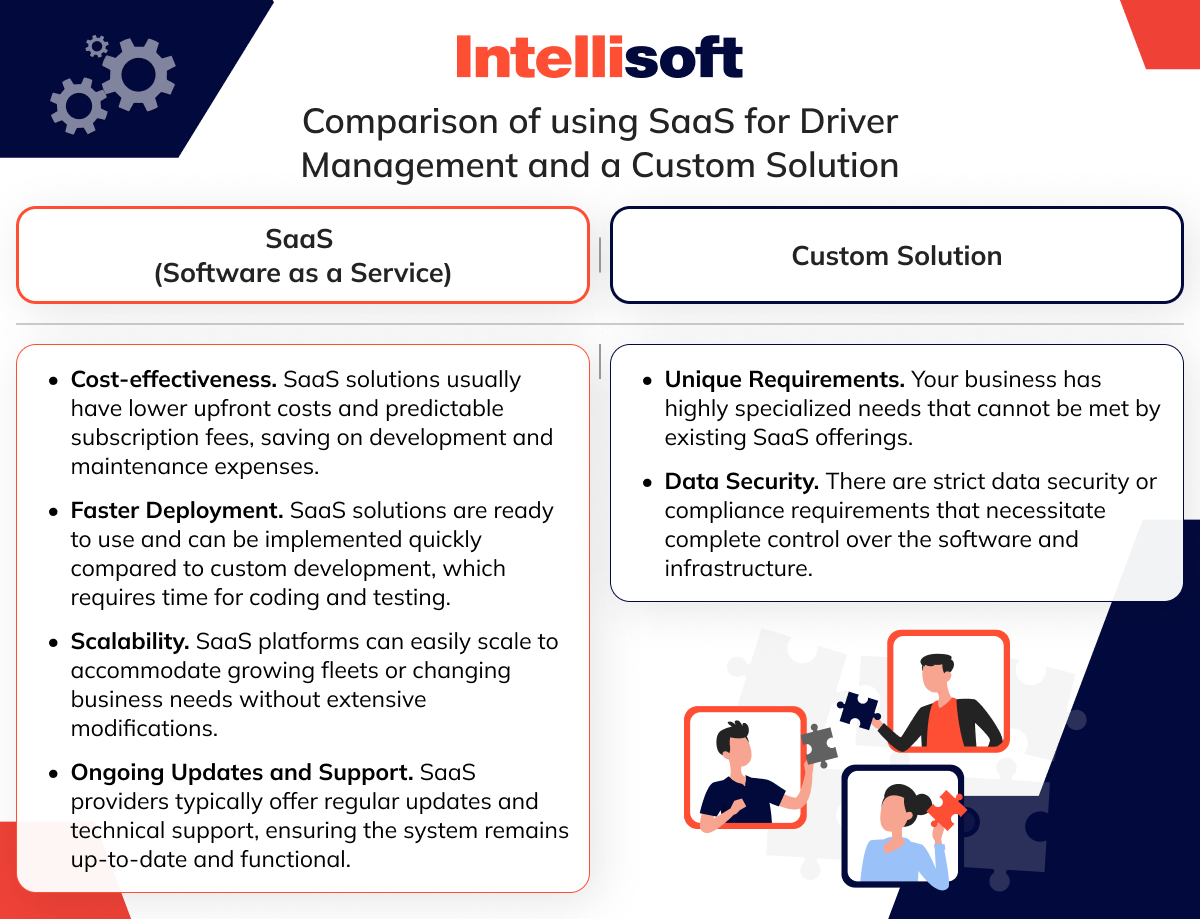
If you want to start effective driver management with SaaS, we’ve gathered the most popular options below, so you can select the best option without wasting time.
Top 5 Fleet Management Apps With Driver Management Software
Our team of experts has carefully analyzed and evaluated a variety of solutions to compile this list of the best driver management software. Our selection process was based on important criteria: functionality, ease of use, scalability, customer support, and affordability. Our top picks are solutions that offer comprehensive features, intuitive interfaces, and robust support systems to ensure seamless integration and maximum value for our readers.
Driveroo

Driveroo is a comprehensive driver management system designed to empower drivers and fleet managers by providing enhanced performance capabilities. The software facilitates proactive driver risk management by sending real-time notifications for any missed or incomplete tasks. Moreover, Driveroo’s geofencing feature allows for real-time monitoring of vehicle locations and sending alerts for deviations from designated routes or locations.
With customizable fleet dashboards and robust reporting capabilities, Driveroo helps fleet managers analyze data effectively, make informed decisions, and optimize fleet performance for improved efficiency and profitability.
Some of the key features Driveroo offers include:
- eDVIR (Electronic Driver Vehicle Inspection Reports). Driveroo has made vehicle inspections paperless by introducing eDVIR for digital inspections.
- Work order tracking. Managers can assign and track maintenance tasks in real-time with Driveroo. This feature facilitates communication between vehicle users, operators, and maintenance staff, ensuring efficient completion of tasks.
- Proactive driver app. Driveroo’s mobile application provides users with easy access to critical reports and information through a user-friendly interface.
FleetWave

FleetWave is a truck driver management software that aims to enhance the efficiency of fleet operations and optimize vehicle user performance. It offers various tools that help fleet managers monitor driver records, automate compliance reminders, and track key metrics such as fuel economy and safety. The software empowers fleet managers to keep their personnel informed and their fleets running smoothly.
FleetWave also simplifies preventative maintenance scheduling and promotes safety and compliance, thus ensuring operational efficiency while minimizing downtime and risk.
Some of the key features of FleetWave include:
- Comprehensive driver records. FleetWave allows managers to maintain organized and up-to-date records of personal information, including licenses, training, and contact details.
- Driver performance tracking. FleetWave allows managers to monitor fuel efficiency, safety, and productivity metrics related to vehicle user performance.
- Asset allocation. This truck driver management system allows for real-time tracking of vehicle and equipment assignments to people for efficient asset management and resource allocation.
- Customizable reporting. FleetWave is a software that offers reporting tools you can customize to generate detailed fleet reports and analyze performance metrics.
TruckLogics

TruckLogics is a truck driver management system designed specifically for the trucking industry. Its purpose is to help fleet managers effectively manage their chauffeurs.
With TruckLogics, communication with vehicle users is easy and efficient, settlements are managed intelligently, and routes are planned effectively. The system also includes a mobile app that vehicle users can use to upload dispatch expenses, electronically sign Bills of Lading (BOLs), and send automatic load status notifications to customers.
TruckLogics is the ideal solution for trucking businesses looking to simplify fleet driver management and improve operational productivity. Some key features offered by TruckLogics are:
- Driver account settings. TruckLogics enables fleet managers to create and manage driver accounts. Vehicle users can access the mobile app with customized permissions.
- Driver communication. Fleet managers can use text or email to notify people of assigned or canceled dispatches and upcoming maintenance.
- Driver log. TruckLogics’ mobile driver management app allows drivers to log duty status, record DVIRs, and add check calls, fuel-ups, expenses, and documents.
- Route planner. The truck route planner automatically calculates the optimal routes and provides comprehensive information, including load details, distance between stops, estimated travel time, and recommended stop durations.
Driver Schedule

Driver Schedule is a software solution that simplifies modern driver management for transportation and logistics companies. It streamlines scheduling, organization, and tracking to optimize chauffeur performance and company efficiency.
The truck driver management system automates the scheduling process, manages fluctuating personal schedules, and implements consistent policies and rules. It even tracks employee time off, efficiently manages vehicle issues and maintenance, and enables the implementation of recurring training programs.
Driver Schedule offers a range of features, including staff scheduling, driver availability tracking, time-off management, payroll tracking, training management, fleet maintenance, appointment scheduling, GPS tracking, and more. These features make it easy for businesses to manage their personnel effectively and stay on top of everything related to their fleet.
Critical features of Driver Schedule involve:
- Staff scheduling. Driver Schedule enables managers to create and manage vehicle user schedules efficiently, ensuring optimal resource allocation and coverage.
- Driver availability. This feature allows managers to monitor vehicle user availability in real-time, simplifying scheduling decisions and minimizing potential scheduling conflicts.
- Shift scheduling. Managers can easily create and manage driver shift schedules, ensuring adequate shift coverage and effective resource allocation.
- GPS tracking. The software includes GPS tracking features, enabling managers to monitor routes and performance and track vehicle locations in real-time.
Fleetio

Fleetio is a powerful fleet driver management software that enables managers and personnel to manage their fleets efficiently. Its user-friendly interface and robust functionalities allow organizations to effortlessly track and monitor their fleet assets, from managing vehicle user schedules and assignments to tracking vehicle maintenance and expenses. Fleetio’s advanced reporting and analytics capabilities also provide valuable insights into fleet operations, helping organizations identify trends and make informed decisions to drive business growth and success.
Key features of Fleetio include:
- Fleet asset tracking. Effortlessly manage your mobile assets by tracking fleet data, storing important documents, and monitoring asset utilization to optimize fleet performance while reducing costs.
- Driver fleet management reporting. Get real-time alerts, customizable data visualization, and detailed reporting to increase visibility into fleet operations.
- Fleet maintenance. Automate maintenance triggers, handle services, and resolve issues with features such as preventive maintenance scheduling, electronic vehicle inspections, recall alerts, and vehicle issue management.
How To Build A Custom Driver Monitoring App From Scratch
A custom driver management app can help users improve their operations and fill any gaps that may exist. If you still rely on outdated processes, such as paperwork, or your routing is not optimized, you could be losing money.
It is important to consider your business needs to create the best driver management software. What does your company do? What are the routine tasks of every employee, and how can they be assisted?
If you are having trouble identifying these points, you can consult with a tech expert and book a project discovery service. This service will help sort out all the technical aspects of the project concept and provide cost estimates.
The technical side of the project that developers can take care of includes:
- The technical and non-technical project requirements
- Design wireframes
- Tech stack
- Architecture
- Project roadmap
- Feature-based cost estimation
The goal of the app is to be a one-in-all truck driver management system. It should be a tool that allows them to perform and report all tasks while ensuring no need to double-check the information. Some possible features include:
- Time logs
- Driver status
- Reports (such as incident or vehicle inspection reports)
- Task progress
- Navigation
- In-built chat
- Emergency buttons
- Notifications
How Much Does Driver Management Software Cost?
Have you decided to create a driver management system tailored to your business needs but are hesitant to start due to concerns about the cost? Don’t worry, we understand that everyone wants to know the development costs upfront and may fear hidden costs.
At Intellisoft, we can provide you with a detailed cost and time estimate so that you are fully aware of the expenses involved. The main factor that influences the price is the complexity of the system. To explore the potential of your idea, we offer a project discovery phase that can last from one to three weeks, depending on how sophisticated your solution is. Once the discovery phase is complete, you will receive a roadmap for your project.
Here’s a detailed table outlining the various costs associated with developing an IoT app, which will give you a clear breakdown of expenses and help you to budget effectively for your project.

Conclusion
The transport and logistics industry has changed significantly by adopting advanced software solutions. IntelliSoft is a company that specializes in creating cutting-edge fleet driver management software. We strive to provide innovative solutions tailored to meet businesses’ evolving needs while ensuring efficiency, safety, and streamlined operations.
We offer SaaS and custom solutions with user-friendly interfaces, data analytics capabilities, and support systems for vehicle user management. For instance, our partnership with Ingram Barge provides a solution for freight brokers to plan routes, track all stages of the process, and store barges until the next shipment.
If you want to transform your driver management strategy and address existing challenges, contact us today!


